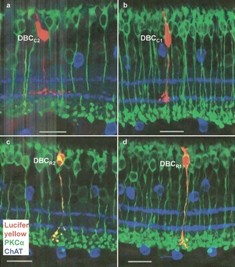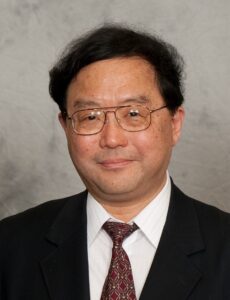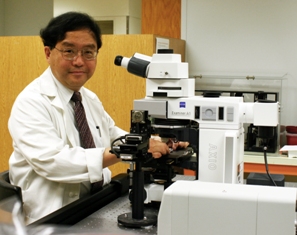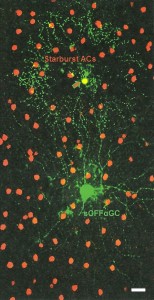- Retina Research Foundation
- About RRF
- Pilot Study Grants
- Grant Recipients 2025
- Samuel M. Wu, PhD
- Yingbin Fu, PhD
- Graeme Mardon, PhD
- Wei Li, PhD
- Yuqing Huo, MD, PhD
- Rui Chen, PhD
- Wenbo Zhang, PhD
- Curtis Brandt, PhD
- Lih Kuo, PhD
- Timothy Corson, PhD
- Jianhai Du, PhD
- Francesco Giorgianni, PhD
- James Monaghan, PhD
- Seongjin Seo, PhD
- Andrius Kazlauskas, PhD
- Erika D. Eggers, PhD
- Ann C. Morris, PhD
- Ming Zhang, MD, PhD
- Christine Sorenson, PhD
- Alex J. Smith, PhD
- Jeffrey M. Gross, PhD
- David M. Wu, MD, PhD
- Kinga Bujakowska, PhD
- Eric Weh, PhD
- Ching-Kang Jason Chen, PhD
- Jakub K. Famulski, PhD
- Thanh Hoang, PhD
- Georgia Zarkada, MD, PhD
- Eleftherios Paschalis Ilios, PhD
- Oleg Alekseev, MD, PhD
- Erika Tatiana Camacho, PhD
- Patricia R. Taylor, PhD
- Elizabeth Vargis, PhD
- Publications
- Grant Guidelines and Information
- Grant Application
- Grant Recipients 2025
- Research Programs
- Contact Us
- Giving
- RRF History
- Home
Samuel M. Wu, PhD
Cullen Eye Institute
Baylor College of Medicine
Houston, TX
KAYSER RESEARCH PROJECT
Pharmacological and Genetic Mechanisms Underlying Retinal Cell Death in Glaucoma and Age-related Macular Degeneration
Major Awards
- 2020 Paul Kayser International Award in Retina Research (International Society for Eye Research – ISER)
- 2011 Alcon Research Institute Award
- 2009 Friedenwald Award (Association for Research in Vision and Ophthalmology)
- 2008 Ludwig von Sallmann Prize (International Society for Eye Research)
Current Research Interests
Dr. Wu’s research project objective is to understand synaptic mechanisms underlying the function and dysfunction of the retina in glaucoma and age-related macular degeneration (AMD). By using the newly developed 8 patch electrode recording system (first time in retinal research) and the multi-electrode array system and reverse correlation methods, his lab has successfully studied synaptic connectivity in the retina and spatiotemporal receptive field properties of retinal ganglion cells (RGCs). Results obtained from these studies will enable determination of how various retinal synapses and neurons mediate normal retinal function, and how they affect retinal dysfunction and cell death in retinal diseases including glaucoma and AMD. Moreover, our results will help to design drug and gene therapies targeting on dysfunction sites in the retina as new remedies for glaucoma and AMD.
Plans for 2024
Dr. Wu’s lab team will continue their research efforts to study synaptic connectivity in normal and disease retinas by using the state-of-the-art 8 channel patch clamp recording and the multi-electrode array systems. They will investigate postsynaptic responses elicited by current injections into presynaptic retinal neurons and the receptive fields of retinal ganglion cells (RGCs) in normal, AMD and glaucomatous retinas. They will also identify targets for drug and gene therapies for treating glaucoma and AMD. specifically, they will study photoreceptor-bipolar cell-retinal ganglion cell (RGC) synapses in healthy and glaucomatous retinas. Additionally, they will determine the linear and non-linear behaviors of the photoreceptor coupled network that regulate retinal function in age-related macular degeneration (AMD).
Progress in 2023
In 2023, Dr. Wu attended the 2023 ISER meeting in Australia and received the Retina Research Foundation Paul Kayser Award International Award in Retina Research and presented a poster. His lab attended the annual ARVO meeting and presented two posters. Dr. Wu was invited to present seminars at Yale, Columbia and Stanford University. Moreover, Dr. Wu was awarded a new National Eye Institute T32 grant for five years. His group has completed four lines of research, with three publications and one submitted manuscript.
Progress in 2022
In 2022, Dr. Wu introduced the 2022 Friedenwald awardee at ARVO in May, presented a poster at the FASEB meeting in June and gave a seminar in the Department of Biological Sciences at the University of Virginia, Charlottesville in September. His lab completed four lines of research projects, two papers were submitted for publication and two additional manuscripts are in preparation.
Progress in 2021
Dr. Wu’s lab published four papers and submitted two manuscripts in top international journals. These publications report their new discoveries on how rod and cone signaling pathways mediate light responses in retinal bipolar cells, and how dysfunction of photoreceptors, bipolar cell and amacrine cell synapses affect retinal degeneration in various forms of retinal and brain diseases. Because of the Covid pandemic, Dr. Wu and his lab members did not give presentations at the Association for Research in Vision and Ophthalmology (ARVO) annual meeting in 2021.
Progress in 2020
In spite of the interruptions of the 2020 Covid-19 pandemic, Dr. Wu published three papers and submitted three manuscripts to top international journals. These publications report on Dr. Wu’s new discoveries related to genetic dissection and glycinergic and GABAergic modulation of amacrine cells on retinal ganglion cell receptive fields in normal and experimental glaucoma mice, and how pathway-specific mutant mice affect synaptic pathways and pathogenesis of glaucoma and AMD. Please view his 2020 Publications to find links to his work.
Dr. Wu’s group continued their research efforts in developing the state-of-the-art eight (8) channel patch clamp recording system for simultaneous recordings of multiple retinal neurons and studying their synaptic connectivity in normal and disease states. They worked on development of new computerized optokinetic reflex recording system to study changes in motion sensitivity of visual neurons in healthy and diseased retinas. Moreover, they used the multi-electrode array (MEA) recording system to study receptive fields and motion selectivity of retinal ganglion cells (RGCs) in normal, AMD and glaucoma retinas. They correlated the MEA recorded RGC units with various morphological and functional RGC types established by single cell patch clamp recordings. These studies progressed forward Dr. Wu’s efforts to identify targets for drug and gene therapies to treat RGC dysfunction in glaucoma and AMD.
Progress in 2019
Dr. Wu’s lab published three papers and submitted three manuscripts in top international journals. These publications report their new discoveries on how rod and cone signaling pathways mediate light responses in retinal bipolar cells, and how dysfunction of photoreceptors, bipolar cell and amacrine cell synapses affect retinal degeneration in various forms of retinal and brain diseases. Dr. Wu and his lab members shared their progress in presentations at the Association for Research in Vision and Ophthalmology (ARVO) annual meeting in May, 2019 in Vancouver, Canada.
 Sam Wu, PhD, imaging retinal sections in preparation for electrophysiological recordings from mutant and diseased retinal neurons
Progress in 2018
Sam Wu, PhD, imaging retinal sections in preparation for electrophysiological recordings from mutant and diseased retinal neurons
Progress in 2018

In 2018, three papers were published and three manuscripts submitted in renown international journals detailing new discoveries on how rod and cone signaling pathways mediate light responses in retinal bipolar cells, and how dysfunction affects retinal degeneration. Dr. Wu’s lab researchers gave three presentations at the Association for Research in Vision and Ophthalmology (ARVO) annual meeting in May, 2018 in Honolulu, Hawaii, and one presentation at the FASEB meeting in July, 2018 in Buffalo, New York.
Specific aims addressed throughout the year included: Aim 1 – how bipolar cells, amacrine cells and ganglion cells are interconnected in the inner retina, and how bipolar cell signals converge to various types of retinal ganglion cells; Aim 2 – light responsiveness, center and surround receptive fields of retinal ganglion cells in normal, mutant and diseased retinas; Aim 3 – how individual pre-ganglion retinal neurons drive various types of ganglion cells.
Progress in 2017
Dr. Wu’s lab published five papers and submitted four manuscripts in top international journals. These publications report their new discoveries on how rod and cone signaling pathways mediate light responses and receptive fields of various types retinal ganglion cells (RGC), and how dysfunction of bipolar cell and amacrine cell synapses affect retinal degeneration in glaucoma, AMD and retinitis pigmentosa (RP). In collaboration with Dr. Sardiello’s lab, Dr. Wu’s group also studied how mechanistic target of rapamycin complex 1 (mTORC1), a known TFEB inhibitor, regulates neurodegenerative storage diseases in the brain and the retina. Dr. Wu and his lab members gave five presentations at the Association for Research in Vision and Ophthalmology (ARVO) annual meeting in May, 2017 in Baltimore, Maryland.
Progress in 2016
Dr. Wu’s lab published five papers and submitted four manuscripts in top international journals. These publications report their new discoveries on how rod and cone signaling pathways mediate light responses and receptive fields of various types retinal ganglion cells (RGC), and how dysfunction of bipolar cell and amacrine cell synapses affect retinal degeneration in glaucoma, AMD and retinitis pigmentosa (RP). In collaboration with Dr. Wensel’s lab, Dr. Wu’s group also studied how light regulates phosphatidylinositol-3-phosphate in retinal rods. Dr. Wu and his lab members gave six presentations at the Association for Research in Vision and Ophthalmology (ARVO) annual meeting in May, 2016 in Seattle, WA, and one presentation at the FASEB meeting in July, 2016 in Denver, CO.
Progress in 2015
Dr. Wu’s lab published five papers and submitted three additional manuscripts in top international journals. These publications report their new discoveries on how retinal ciliopathy gene affects retinal disease progression, how elevation of intraocular pressure results in retinal ganglion cell sensitivity decrease and cell loss in glaucoma, how elevated intracranial pressure (ICP) causes optic nerve and retinal ganglion cell degeneration, and how protein kinase C α (PKCα) modulates rod bipolar cell function in the mammalian retina. Dr. Wu and his lab members gave six presentations at the ARVO annual meeting in May, 2015 in Denver, CO, and one presentation at the Society for Neuroscience meeting in October, 2015 in Chicago, IL.
Progress in 2014
Dr. Wu’s lab published three papers and submitted four manuscripts in top international journals. These publications report their new discoveries on how various isoforms of glutamate transporters affect signal transmission from photoreceptors to second-order retinal neurons, and how dysfunction of the photoreceptor output synapses may mediate retinal degeneration in glaucoma, AMD and retinitis pigmentosa (RP). Dr. Wu and his lab members gave four presentations at the Association for Research in Vision and Ophthalmology (ARVO) annual meeting in May, 2014 in Orlando, Florida and one presentation at the International Society for Eye Research meeting in July, 2014 in San Francisco, California.
Progress in 2013
During the past year, Dr. Wu’s lab published four papers in top international journals including Investigative Ophthalmology and Visual Sciences, and Journal of Physiology. These publications report new discoveries on new animal models for glaucoma, AMD and retinitis pigmentosa (RP), as well as physiological and pharmacological properties of healthy and diseased retinal neurons. Dr. Wu and his lab members gave four presentations at the Association for Research in Vision and Ophthalmology (ARVO) 2013 annual meeting in Seattle, and presented two keynote lectures at two International Symposia of Ophthalmology in November, 2013 in Guangzhou and Beijing, China.
Confocal image of a flat-mounted retina of a ChAT-cre fluorescence mouse, in which all cholinergic amacrine cells show red fluorescence. A starburst amacrine cell (arrow) and a sustained OFF alpha ganglion cell (sOFFαGC) were filled with neurobiotin (green) via whole-cell patch electrodes. Calibration bar: 10µm
Progress in 2012
Dr. Wu’s lab published five papers in top international journals including, Investigative Ophthalmology and Visual Sciences, Journal of Physiology, Vision Research and Human Molecular Genetics. These publications report new discoveries on new animal models for retinitis pigmentosa (RP) and Leber congenital amaurosis, as well as physiological and pharmacological properties of healthy and diseased mouse retinal neurons. Dr. Wu and his lab members gave four presentations at the Association for Research in Vision and Ophthalmology (ARVO) annual meeting in May, 2012 at Ft. Lauderdale, Florida, and one presentation at the International Society of Eye Research (ISER) meeting in July, 2012 in Berlin, Germany.
Dr. Wu continued his highly successful research in studying mechanisms of retinal degeneration and developing new gene therapy vectors for BBS, AMD and glaucoma patients. Additionally, his group studied synaptic mechanisms underlying retinal ganglion cell death in acute and chronic glaucoma models, and developed and constructed new non-invasive devices for early detection/diagnosis of AMD and glaucoma in animals and humans.
Dr. Wu’s research is focused on molecular and synaptic mechanisms underlying retinal cell death in age-related macular degeneration (AMD) and glaucoma, and to develop new gene therapy vectors for rescuing retinal degeneration in these diseases.
His group has been successful in demonstrating that gene therapy prevents photoreceptor degeneration in a Bardet-Biedl Syndrome mouse model, and in developing a new microinjection system for ocular delivery of pharmacological agents and viral/gene conjugates. His lab also designed new non-invasive devices for early detection of photoreceptor and ganglion cell dysfunction in animals and humans. They use these new tools in conjunction with electrophysiological and pharmacological techniques to develop new treatment and prevention strategies for fighting human AMD and glaucoma.
Confocal microscope photo of mouse retinal bipolar cells filled with Lucifer yellow (red) and counter-stained with PKCa (green) and ChAT (blue)
Progress in 2011
Dr. Wu’s lab published four papers in top international journals including Proceedings of the National Academy of Sciences (USA), Molecular and Cellular Biology, Investigative Ophthalmology and Visual Sciences and Journal of Comparative Neurology.
These publications report new discoveries on the first successful gene therapy that prevents photoreceptor degeneration in a Bardet Biedl Syndrome (BBS) animal model, and on physiological, pharmacological and genetic properties of healthy and diseased mouse retinas. BBS is a devastating blinding disease for children, and this is a ground-breaking study in developing a successful gene therapy protocol for rescuing photoreceptors in BBS.
The first successful gene therapy for this blinding disease, Dr. Wu’s study constitutes a major step towards a cure for BBS in human patients. Using a tiny benign virus to take a missing gene to the rods and cones of the retina in the mice with this syndrome, Dr. Wu’s lab was able to demonstrate that blindness was prevented. Photoreceptors that were treated survived, and after the gene therapy mice that had been treated responded to visual stimuli.
Dr. Wu and his lab members gave six presentations in the Association for Research In Vision and Ophthalmology (ARVO) annual meeting in May, 2011, at Ft. Lauderdale, Florida.




